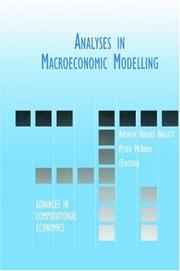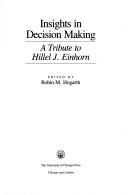| Listing 1 - 10 of 392 | << page >> |
Sort by
|
Book
Year: 1982 Publisher: Cambridge, Mass. National Bureau of Economic Research
Abstract | Keywords | Export | Availability | Bookmark
 Loading...
Loading...Choose an application
- Reference Manager
- EndNote
- RefWorks (Direct export to RefWorks)
This paper presents a dynamic model of the industrial demands for structures, equipment, and blue- and white-collar labor. Our approach is consistent with producers holding rational expectations and optimizing dynamically in the presence of adjustment costs, yet it permits generality of functional form regarding the technology. We represent the technology by atranslog input requirement function that specifies the amount of blue-collar labor (a flexible factor) the firm must hire to produce a level of output given its quantities of three quasi-fixed factors that are subject to adjustment costs: non-production (white-collar) workers, equipment, and structures.A complete description of the production structure is obtained by simultaneously estimating the input requirement function and three stochastic Euler equations.We apply an instrumental variable technique to estimate these equations using aggregate data for U.S. manufacturing. We find that as a fraction of total expenditures, adjustment costs are small in total hut large on the margin,and that they differ considerably across quasi-fixed factors. We also present short- and long-run elasticities of factor demands.
Book
Year: 1984 Publisher: Cambridge, Mass. National Bureau of Economic Research
Abstract | Keywords | Export | Availability | Bookmark
 Loading...
Loading...Choose an application
- Reference Manager
- EndNote
- RefWorks (Direct export to RefWorks)
This paper examines five examples of rational expectations models with a continuum of convergent solutions and demonstrates serious difficulties in the economic interpretation of these solutions. The five examples are (1) a model of optimal capital accumulation with a negative rate of time preference, (2) Taylor's (1977) linear rational expectations model of macroeconomic equilibrium; (3) Calvo's (1984) model of contract setting and price dynamics; (4) Obstfeld's (1984) equilibrium model of monetary dynamics with individual optimizing agents; and (5) Calvo's (1978) life-cycle model of savings and asset valuation. In every case, when these models yield a continuum of convergent infinite horizon solutions, these solutions fail to exhibit economically appropriate, forward looking dependence of the endogenous variables on the paths of the exogenous forcing variab1es--a difficulty that does not arise under the circumstances where these models yield unique convergent infinite horizon solutions. Further, the three models that have natural finite horizon versions, either lack finite horizon solutions or have solutions that do not converge to any of the infinite horizon solutions. Again, this difficulty arises only under the circumstances where these models have a continuum of infinite horizon solutions.
Book
ISBN: 9781498778619 Year: 2024 Publisher: Boca Raton, FL : CRC Press,
Abstract | Keywords | Export | Availability | Bookmark
 Loading...
Loading...Choose an application
- Reference Manager
- EndNote
- RefWorks (Direct export to RefWorks)
Computational Methods in Finance is developed from the author's courses at Columbia University and the Courant Institute of New York University. This text is designed for graduate students in financial engineering and mathematical finance as well as practitioners. It will help readers accurately price a vast array of derivatives.

ISBN: 0792385985 9780792385981 Year: 1999 Publisher: Boston: Kluwer,
Abstract | Keywords | Export | Availability | Bookmark
 Loading...
Loading...Choose an application
- Reference Manager
- EndNote
- RefWorks (Direct export to RefWorks)
Book
ISBN: 0691155232 9780691155234 Year: 2013 Publisher: Princeton (N.J.): Princeton university press,
Abstract | Keywords | Export | Availability | Bookmark
 Loading...
Loading...Choose an application
- Reference Manager
- EndNote
- RefWorks (Direct export to RefWorks)
Book
Year: 2005 Publisher: Washington, D.C. : International Monetary Fund,
Abstract | Keywords | Export | Availability | Bookmark
 Loading...
Loading...Choose an application
- Reference Manager
- EndNote
- RefWorks (Direct export to RefWorks)
This note provides an update of the assessment of Lao P.D.R.'s macroeconomic conditions and outlook presented at the time of the 2004 Article IV.
Book
ISBN: 1498372104 Year: 2005 Publisher: Washington, D.C. : International Monetary Fund,
Abstract | Keywords | Export | Availability | Bookmark
 Loading...
Loading...Choose an application
- Reference Manager
- EndNote
- RefWorks (Direct export to RefWorks)
This note provides an update of the assessment of Lao P.D.R.'s macroeconomic conditions and outlook presented at the time of the 2004 Article IV.
Book
ISBN: 0335008151 9780335008155 Year: 1973 Publisher: Walton Hall: Open university press,
Abstract | Keywords | Export | Availability | Bookmark
 Loading...
Loading...Choose an application
- Reference Manager
- EndNote
- RefWorks (Direct export to RefWorks)
Book
Year: 1964 Publisher: London: Edward Arnold,
Abstract | Keywords | Export | Availability | Bookmark
 Loading...
Loading...Choose an application
- Reference Manager
- EndNote
- RefWorks (Direct export to RefWorks)

ISBN: 0226348555 9780226348551 Year: 1990 Publisher: Chicago: University of Chicago,
Abstract | Keywords | Export | Availability | Bookmark
 Loading...
Loading...Choose an application
- Reference Manager
- EndNote
- RefWorks (Direct export to RefWorks)
Economics --- Rational expectations (Economic theory) --- Choice (Psychology)
| Listing 1 - 10 of 392 | << page >> |
Sort by
|

 Search
Search Feedback
Feedback About UniCat
About UniCat  Help
Help News
News